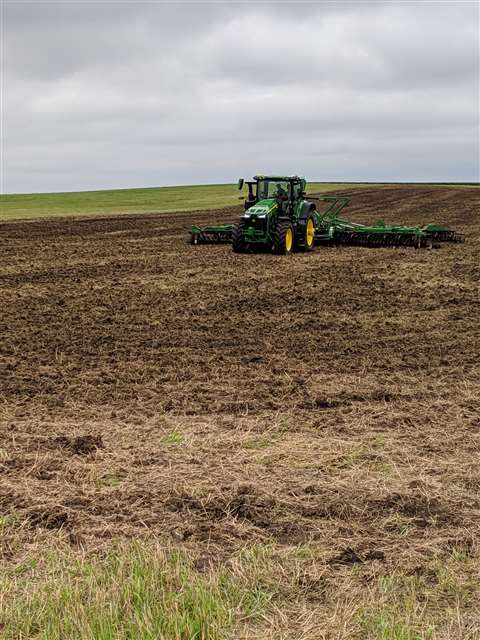Trendlines: Farming is on fire, but can it last?
29 July 2021
Peter Yengst explains how confidence has accelerated within the farming industry as we begin to emerge from the COVID-19 pandemic.
 While drought is a concern for parts of the country, farm tractor sales have been strong for most of this year
While drought is a concern for parts of the country, farm tractor sales have been strong for most of this year
Summer 2021 is in full effect with warmer weather, longer days and recently lifted Coronavirus restrictions. The economy, according to most indicators, is firing on all cylinders with an estimated GDP of 6-7% for Q2 2021.
This reflects a continuation of the economic recovery and the gradual reopening of business. The continued outpouring of government aid related to the COVID-19 pandemic has also played a major role.
Regardless of all the loose money floating around, it is comforting to see that life in North America is once again starting to feel a little more normal.
Some believe it is nothing but blue skies ahead, but are we really out of the clouds yet? I would say not by a longshot, and it will be interesting to see what happens when all the free money stops raining down.
The one thing I look forward to in the summertime is the hotter weather, and it seems like the temperatures are climbing more each year. On the downside, much of the West and Southwest are looking at dire water problems creeping closer each year, and 90% of those areas are considered be in ‘extreme drought’ conditions.
Drought is a growing concern for farmers as their crops are finding it harder to reach full maturity. Shortages in crop yields will lead to even higher prices, so something other than free money better start raining down, and soon.
Commodity prices are hovering at decade highs. Soybeans are up more than 70% from a year ago, corn is up more than 100% and wheat has increased about 35%. Groceries will remind you of these bumps when you cannot escape the store with a cart full of food without being US$200 lighter to your wallet.
Surge in new tractor sales
Farm tractor sales have been enjoying non-stop gains in recent years and are approaching all-time highs. Sales of all tractors (year to date) were up 26% in May compared to 2020 levels. This year started off at a modest rate, but really started shining with the biggest year-over-year increases occurring in March, which was to be expected given that sales were deep in the red 12 months prior to when the virus restrictions started.
Since the beginning of 2021 and through May, solid gains of roughly 25% have been realized in each of the three horsepower categories (under 40 hp, 40-100 hp and above 100 hp), but that growth is starting to soften. This is especially true in the under 40 hp category, which was down 9% in May. Worth keeping an eye on if this becomes a trend.
 Peter Yengst believes that US government aid is partly due to the recent farm equipment sales growth
Peter Yengst believes that US government aid is partly due to the recent farm equipment sales growth
Even before the pandemic, farmers were flush with government aid and subsidies due to the now-infamous trade wars and drought conditions. This helped keep farmers in the game over the past couple of years and should continue, as I do not see the government pulling in its purse strings anytime soon.
In any given year there are a group of OEMs that dominate the farm tractor market – AGCO, CNH (the Case and New Holland brands), Deere and Kubota. From a volume standpoint, under 40 hp tractors account for the highest sales each year – about 70% overall – and have also seen the most growth in recent years.
These compact machines are generally the tractor of choice for smaller farms, especially in the dairy and livestock sectors. They are also commonly found in landscaping and other non-agricultural applications including rental equipment fleets, as they are easily converted into backhoes and other more universal machines by adding simple attachments.
Kubota leads the way
Kubota takes the leading spot in the under 40 hp category with 26% of sales, closely followed by Deere (22%) and New Holland (22%). Collectively, these three brands accounted for about 70% of sales in this class.
Kubota also leads in the 40 to 99 hp tractor segment, with about 25% sales, again followed closely by New Holland and Deere. The three brands represent roughly 60% of sales in this category.
Volumes shrink as you get higher in horsepower and machine size. While Kubota hits the top at under 100 hp, Deere and New Holland are more formidable in the 100 hp and above category where Kubota has fewer machines and sales.
It is fantastic to see that farm equipment sales remain strong, and we can thank US government aid for that. However, with the drier conditions and ongoing supply chain issues, there are still hurdles to overcome that US government money will not fix. Let us hope there is some rain in those clouds for a change.
Trendlines is a column devoted to the off-highway equipment markets, which appears each month in Diesel Progress, written by Peter Yengst - president of Connecticut-based market research and consultancy Yengst Associates.
Click here for a free digital or print subscription
STAY CONNECTED



Receive the information you need when you need it through our world-leading magazines, newsletters and daily briefings.
CONNECT WITH THE TEAM







